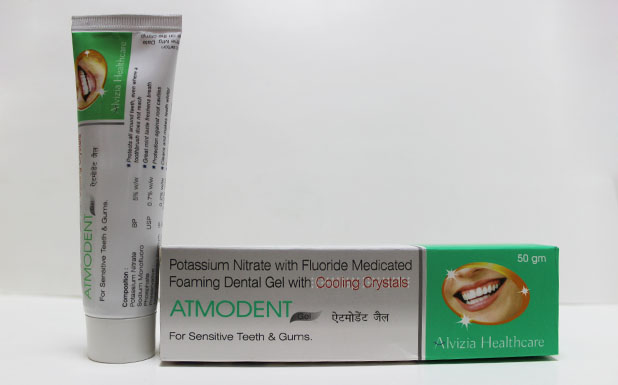
Composition
- Each Tube Contains:
- Potassium Nitrate BP
3% W/W
- Sodium Fluoride IP
0.2% W/W
Packing
- 50 gm
(With Carton)
MRP
- 65
Overview
POTASSIUM NITRATE: This medication is used to prevent cavities and to reduce pain from sensitive teeth (dentinal hypersensitivity). Sodium fluoride works by making the teeth stronger and more resistant to decay caused by acid and bacteria.Potassium nitrate works by calming the nerves in the teeth. These toothpastes contain ingredients such as strontium chloride and potassium nitrate that help block the transmission of pain signals from the surface of your tooth to the nerve inside. They do this by stopping up the tiny tubes in the dentin of your teeth. The dentin is the layer of tissue beneath the hard enamel.
SODIUM FLUORIDE:Sodium fluoride makes teeth more resistant to decay and bacteria that cause cavities This medication is used to prevent cavities.
Indications
It is used primarily indicated in conditions like Pain of hypersensitive teeth.
Mechanism of Action of Potassium Nitrate:
Potassium (K+) is the principal cation modulating the osmotic balance of the body fluids. In animals, the maintenance of normal cell volume and pressure is dependent on Na+ and K+ pumping. Potassium transport through the hydrophobic interior of a cell membrane may be facilitated by several naturally occurring compounds that form lipid-soluble alkali metal cation complexes. Potassium has the critical role of a calcium counter-ion for numerous carboxylates, phosphates, and sulfates, and also acts to stabilize macromolecular structures.
Potassium is the primary agent for common, over the counter de-sensitizing toothpaste that prevents the transmission of nerve endings to the teeth. Potassium salts, including potassium nitrate, potassium chloride or potassium citrate work by diffusion across the dentinal tubules, causing depolarization of the nerve cells. In turn, these cells become unresponsive to excitatory stimuli. The effect of the potassium nitrate accumulates over time, and it may take several weeks for patients to notice improvement of pain symptoms.
Potassium nitrates control pests using a unique mechanism of action. Rather than directly poisoning rodents, nitrates support the combustion of charcoal in gas cartridges, promoting the production of toxic gases, which, are lethal to the target pest. The environmental protection agency in the USA (EPA) is only minimally concerned about the risk of direct human exposure to sodium or potassium nitrates, rather than pesticide accidents--typically involving skin burns or inhalation of toxic gases.
Mechanism of Action of Sodium Fluride:
Fluorides interfere with electron transport and calcium metabolism. Calcium is essential for maintaining cardiac membrane potentials and in regulating coagulation.
Contraindications
- nausea
- rash
- vomiting
Side Effects
- Convulsions
- GI disturbance
- Cyanosis
- Collapse
- Irregular pulse